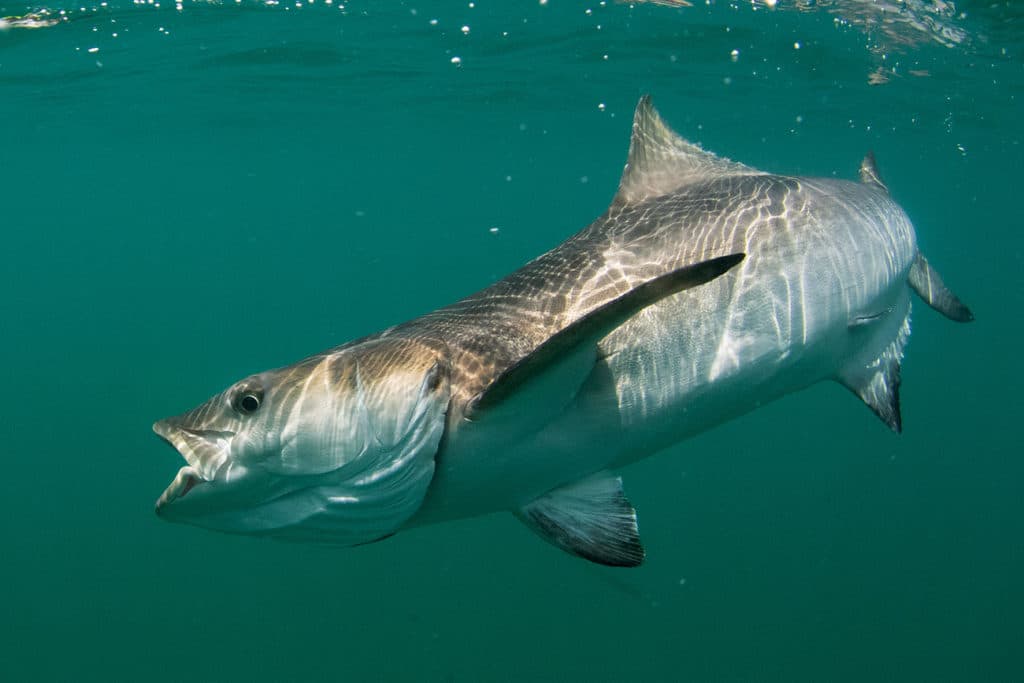
You know the saying “What’s old is new?” Well, the older I get, the more sense it makes. I see the kids pegging their pant legs like we did in the ’80s. Star Wars is more popular than ever. And certain old-school fishing tactics are back in vogue.
When I was a kid, my dad would load us and his gear into his 24-foot Albemarle, carry us across the mouth of Chesapeake Bay to the edge of Inner Middle Ground Shoal and throw out the anchor. He’d break out a half dozen Penn setups rigged with fish-finder rigs. After baiting up with chunks of menhaden, he’d cast the rigs around the boat and deploy a bag of chum. Then, we’d wait.
Fishermen are famous for their patience, but waiting for hours while boiling under the hot sun, all the while swatting flies and listening to the waves slap on the hull, would test the resolve of a saint. Not to mention the weird bycatch fish. Skates, car-hood rays and small sharks were more annoying than the green flies.
In those days, cobia fishermen were a special sort of crazy, suffering the worst conditions to catch one of the biggest inshore trophies. On a hot August afternoon, with thunderstorms on the horizon, the shoals at the mouth of Chesapeake Bay were lined with boats and covered in a sheen of menhaden oil. Many anglers tried to catch these finicky beasts, but few were successful.
Those few had turned cobia fishing into a passion, devoting their lives to the pursuit. The payoff came in one of the largest and most unpredictable coastal game fish. These fish can grow up to 100 pounds, bigger than most inshore sport fish.
No two cobia fight the same. They will run, charge, roll, dive and even jump. Often, a free-swimming cobia will follow a hooked fish to the boat. That’s when real chaos kicks in as the crew scrambles to pitch a bait. Then there are the stories of hooked cobia getting wrapped up in the anchor rope and chum line. I’ve seen guys jump off the boat to free a cobia caught up in bridge pilings. After sacrificing blood, sweat and sanity, they were not about to let a cobia get away.
Chumming for Cobia Lost Favor Over the Last Decade

About 20 years ago, local anglers returning from the fabled cobia waters off Florida brought heavy spinning rods, big bucktails and stories of free-swimming cobia. Within a couple summers, sight-casting towers were popping up like tulips in spring. The chumming hopefuls had become sight-casting cowboys. I was one of them.
If I could catch cobia by driving around the bay at 10 knots, to hell with chumming! The choice seemed obvious. Trade in chum, cut bait, live bait, hours in the sun, no breeze and trash fish for cruising around, face in the wind, a bucket full of eels, a couple of bucktails, two rods and no trash fish. I was sold. So were many, many anglers.
It wasn’t long before I figured out that sight-fishing for cobia isn’t easy either. The sun is just as hot, the fish are just as finicky, the outboard burns more fuel and my success rate improved only slightly. After a couple of summers driving around and going blind staring through the bright sun into the empty water, I was ready to catch a trash fish!
Chumming for Cobia is Popular Once Again
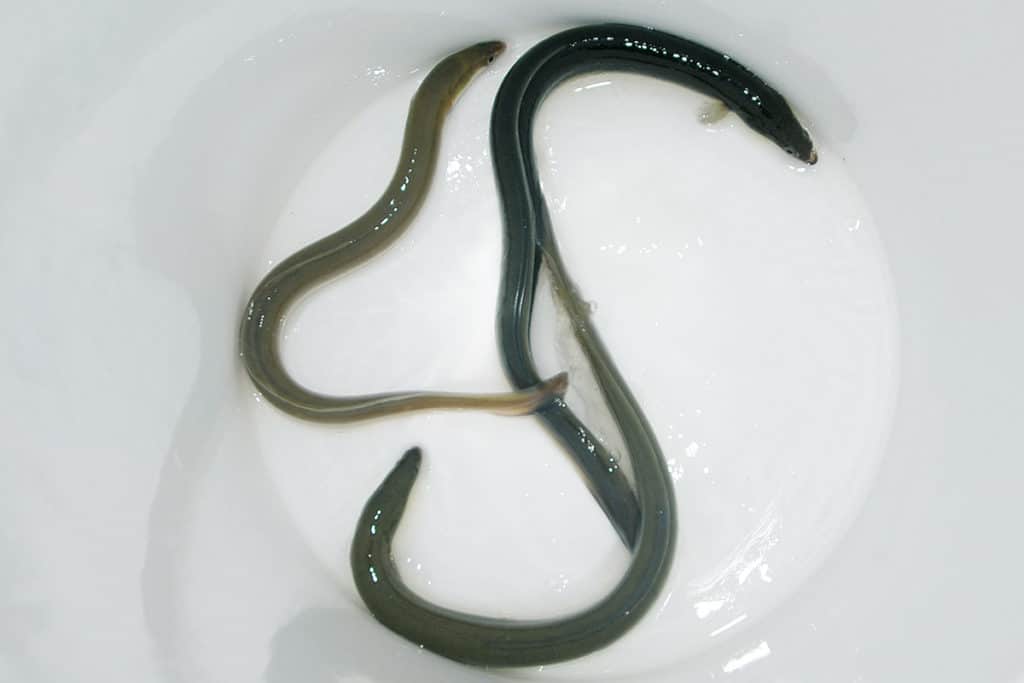
I caught up with my old friend Wes Blow to learn more about chumming for cobia. While the rest of us were sight-fishing, Blow was perfecting his bait-fishing tactics.
“I like the chaos,” he explained to me over the phone. Blow often fishes alone. Juggling a spastic cobia while trying to clear lines, pull in the chum bucket and then land the thrashing fish solo makes his blood run hot. Instead of explaining his methods and madness, he invited me to join him on his next trip.
We met at Wallace’s Marina in Hampton, Virginia, hours before sunrise. Blow loaded the boat with a half dozen three-gallon chum buckets and two dozen eels. He grinds his own chum out of fresh menhaden. His recipe mixes one gallon of menhaden oil with 100 pounds of fish. We ran out of Back River, and Blow stopped the boat in a deep channel. He armed two rods with two-hook bottom rigs baited with Fishbites bloodworm and 2-ounce bank sinkers. We drifted down the channel and quickly added three dozen croaker to the livewell.

By the time the sun peeked over the horizon, we were heading toward the mouth of Chesapeake Bay. Blow said he starts cobia fishing as soon as the water temperature hits 68 degrees. “The first fish show up off Hampton, at York Spit and Bluefish Rock,” Blow said.
On this slick-calm August day, Blow motored to the shoals on the inside side of the Chesapeake Bay Bridge-Tunnel. He anchors on a sharp drop or significant hump so the boat is in shallow water and the chum slick is drifting into the deep. “I like the tide and wind going in the same direction,” he said. “That way the stern of the boat and chum slick are pointing in the same direction.”
With no wind and a morning outgoing tide, Blow anchored along the edge of Inner Middle Ground Shoal so the chum slick trailed toward the bridge. Blow keeps the anchor rope tied to a polyball so he can quickly ditch the anchor when he hooks a big cobia.
As the boat settled in the current, Blow dumped a three‑gallon bucket of chum into a five-gallon bucket with holes drilled in it and diving weights in the bottom. He dropped the bucket over the stern and let it sink to the bottom.
Cobia Fishing Techniques
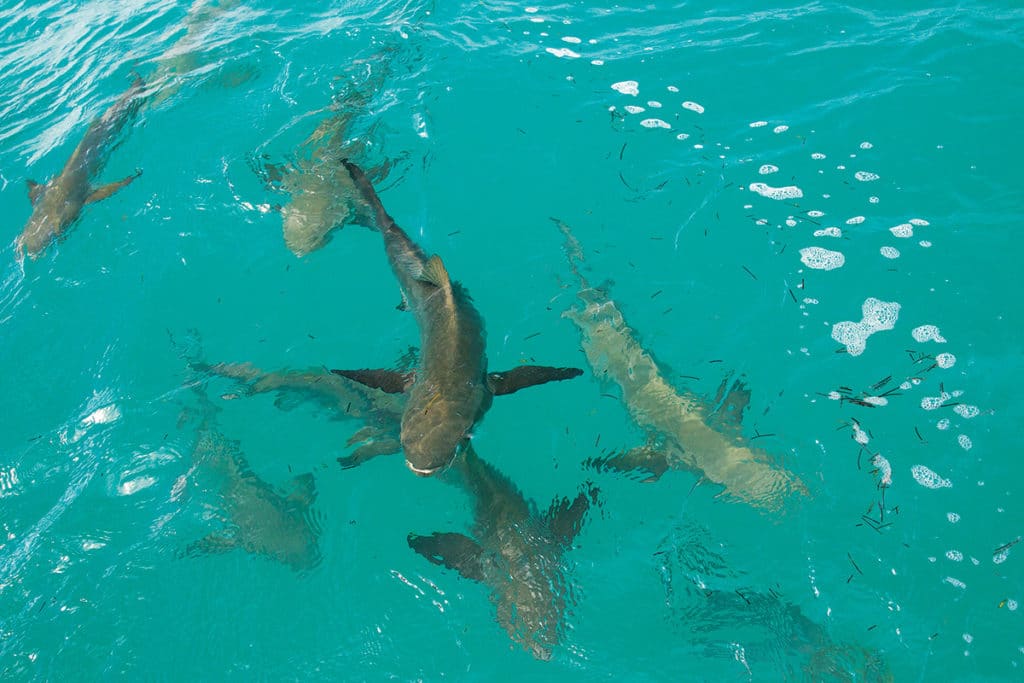
As the greasy slick snaked its way with the current, Blow pulled out four medium-heavy combos spooled with 65-pound braided line. When I noticed that each reel has a different color line, he explained: “If I get a tangle, I quickly know which line is coming from what reel.” I joked, “They must love you at the tackle shop.”
Each rod is outfitted with a fish-finder rig. Blow threaded a plastic fish-finder slide over the braided line and tied on a 250-pound-test swivel. He attached a 2½-foot length of 80-pound Ande monofilament snelled to a big J hook. “I use an 8/0 hook for eels and a 10/0 for croaker,” he said. He likes a J hook because it improves his hookup ratio. “Big cobia have a hard, bony jaw,” he told me. “And a J hook will stick anywhere.” Because cobia often pick up the bait and charge the boat or jump and thrash, Blow feels the J hook has a better chance of finding purchase. “Very few cobia [that I catch] are deep-hooked,” he insisted.

No one is more concerned with the well-being of these brown bombers than Blow, who serves on the South Atlantic Fisheries Management Council subcommittee for cobia. He’s fought for years for sensible regulations to protect both the species and anglers’ rights.
Blow clips 8-ounce pyramid sinkers to two lines. The other two lines get a 4-ounce bank sinker. He drops the heavier sinkers right off the stern. “I catch 75 percent of my fish on the baits right next to the chum bucket.” The other two lines are stationed 20 feet behind the boat. “I catch the biggest fish on the longer lines,” he added.
Blow clears the deck and keeps the menhaden oil scrubbed off. The anchor is ready on the buoy. His rigs are fresh and tackle pristine. “Cobia will test every inch of your gear,” he stressed throughout the day. “You have to be ready when that 100-pounder is on the line.”
Hot Cobia Fishing
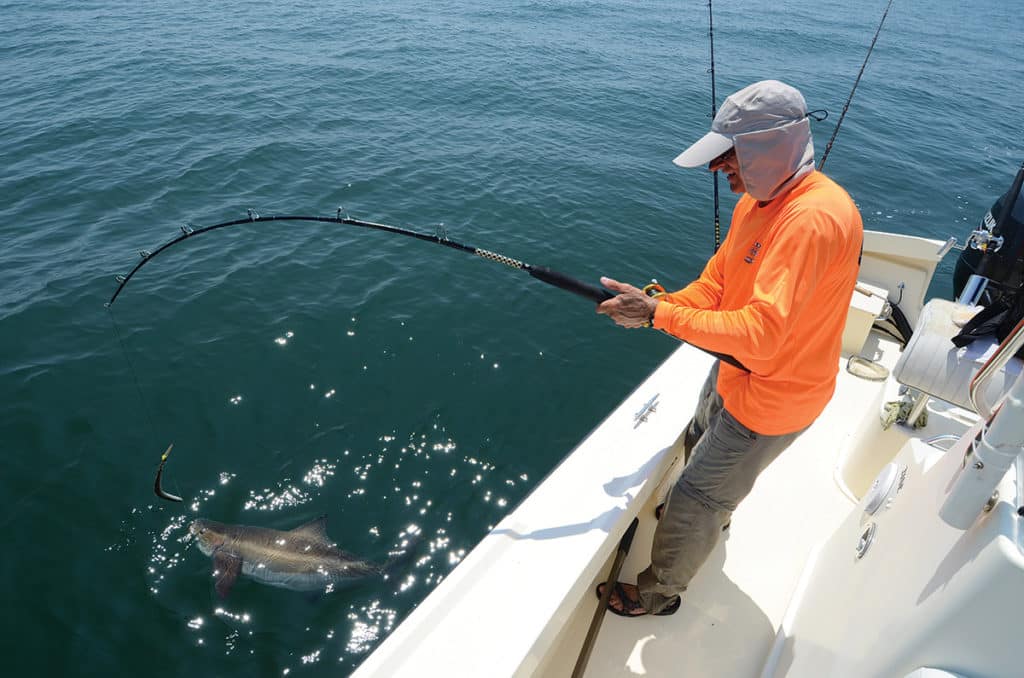
With the lines set and the chum flowing, we sat back and waited. The early morning humidity was already sitting on us like a wet towel. It wasn’t long before we got our first bite. I grabbed my camera, and Blow grabbed the rod. “It’s a shark,” he announced even before seeing the fish.
I stowed the camera, and Blow brought the 4-foot biter to the side of the boat. “Hold the rod,” he ordered, and I obeyed. He reached down, took a couple wraps on the leader, threaded the line onto a dehooker and, with a twist of the wrist, released the shark. The dehooker easily grabbed hold of the J hook, although a circle likely would have had similar results.
Blow rerigged the leader and replaced the bait in the spread. “I must catch a thousand sharks each summer,” he lamented. “Maybe more.” According to Blow, trash fish are just part of the fun. The key is to keep an extra rod rigged up and ready to deploy while fighting a shark or ray.
It wasn’t long before one of the rods bucked heavily. Then the line went slack. Blow was quick to react, jumping on the rod and reeling the line tight. A 3-foot brown fish skirted the surface of the water 30 feet behind the boat. When the fish turned to run, Blow jerked the rod tip to set the hook. Then he engaged the clicker on the reel and put the rod back in the holder. We worked quickly to clear the other rods. I pulled up the chum bucket and left it dangling at the surface. “With the clicker on, I can listen to what the fish is doing while I prepare the boat,” he explained.
Once the lines were in and the deck clear, Blow returned to fighting the cobia. Brown bombers are one of the most unpredictable fish on a line. This one pulled all the tricks. Their favorite move is to come to the boat quickly. When I reached for the net, Blow barked, “I don’t even try to land them when they first come to the boat.” He’s wise to their tricks. “I hit the fish on the head with the net and it will freak out and run again.”
I reached in with the net and scooped a 30-pounder into the boat. The fish slithered on the deck while Blow quickly removed the hook and measured it. Then he inserted an orange spaghetti tag and returned the fish to the water. He held onto the lip and let the cobia regain its composure. When the fish gave a kick that covered Blow with green water, he let it swim away.
By now, the sun was up in full force and the heat building. Blow’s open center console offered no place to hide, and my light clothes stuck to my skin. I gulped water and moved around the boat trying to find any breeze. The surface of the bay was slick-calm, and the boat hardly rocked. Luckily, the fishing was just as hot as the weather. We landed a couple more brown fish in the 20- to 30-pound range as the tide ripped toward the ocean.
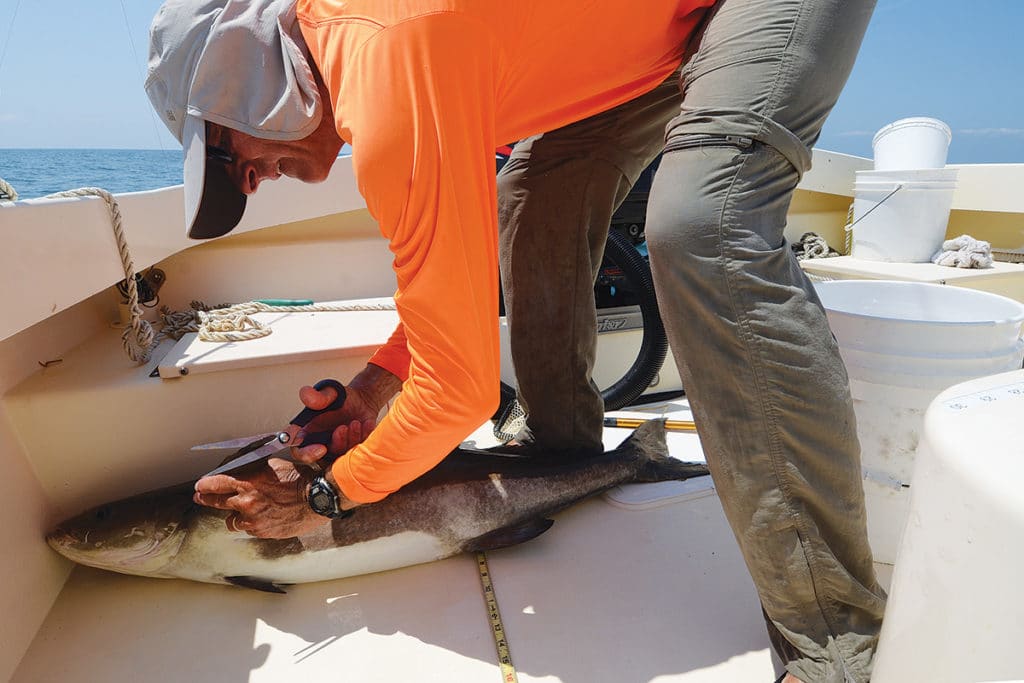
When the current began to slack, Blow moved the boat to the east side of the bridge, where we rode out the incoming tide. We caught more cobia, including one fish that pushed 50 pounds. All of the fish were tagged and released. Sure, we caught a few sharks and rays, but that didn’t rain on the parade. I considered the day a major success.
At one point, I spotted three cobia swimming along the edge of the shoal, 30 yards in front of the boat. I grabbed a heavy spinning reel and 3-ounce bucktail that Blow keeps just for such occasions. With all of my might, I heaved the lure at the idling fish. The bucktail landed with a splash a few feet ahead of the pack. I watched their fins slash the surface, I gave the rod tip a jerk and all three fish turned on the bucktail. I let the lure drop. The fish swam down.
I jigged again, cranked a few feet of line, jigged again, but nothing happened. I did everything right, but sometimes cobia simply won’t cooperate with a lure presentation. All the more reason to chum for them.
After hours of action, we’d released a half dozen cobia. Each fish fought its own fight. With one of us on the reel and the other scooting around the cockpit, we were able to control the chaos. I saw Blow’s point about action. Too many times I’ve gone all day sight-fishing without taking the rod out of the holder. That definitely won’t happen when chumming up cobia.
Virginia Game Fish Tagging Program
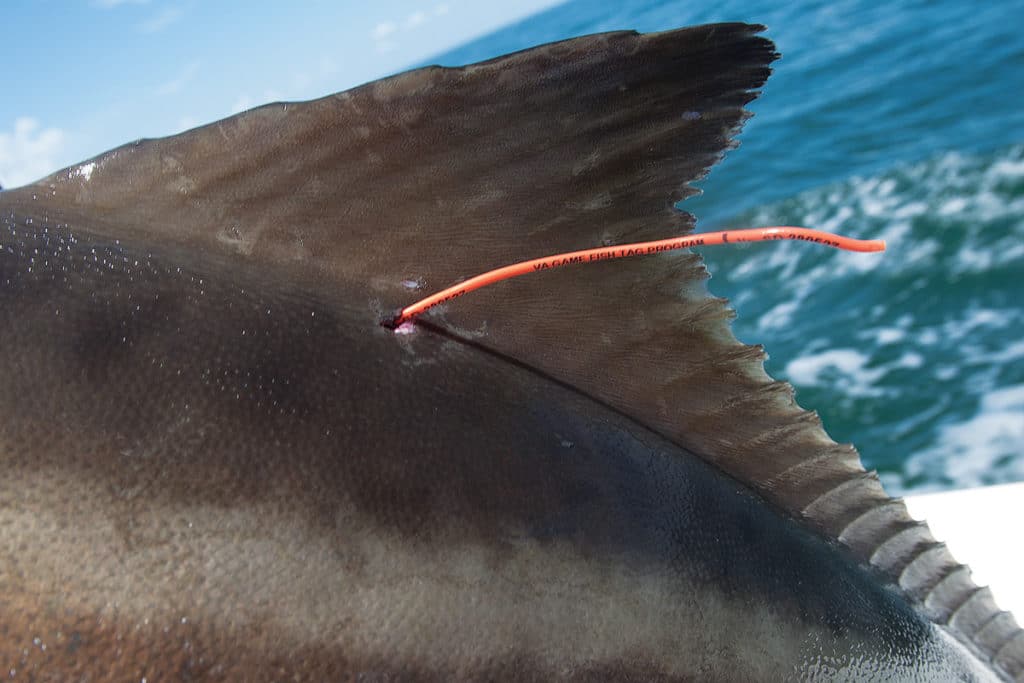
In an effort to track fish movements and monitor populations, the Virginia Game Fish Tagging Program recruits volunteer anglers to place numbered tags in 11 species of sport fish. Participants are trained on how to insert tags and record data. The resulting information plays a big part in tracking fish numbers and setting regulations. Cobia have been a big star of the program: One fish tagged in Virginia was recaptured in the Gulf of Mexico, off Texas. Wes Blow tags dozens of cobia each summer. Because he receives a notification when one of his tags is returned, the information helps him refine his cobia strategy. To get involved in the program, visit mrc.virginia.gov.
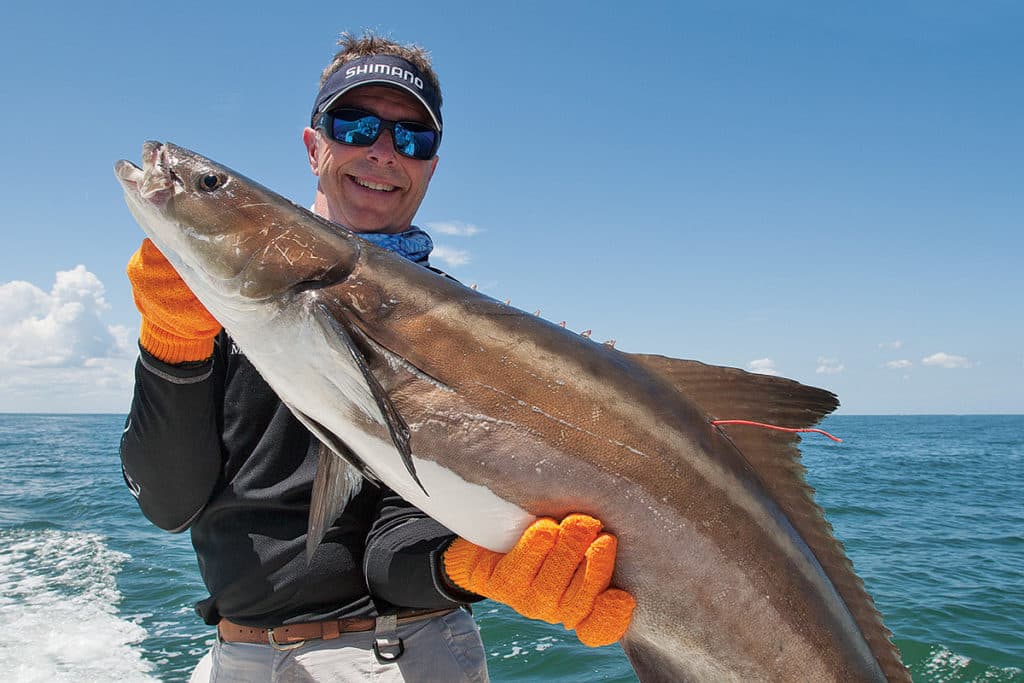
Cobia Fishing Supply List
- Medium-heavy conventional or spinning combos spooled with 80-pound braided line
- 8-ounce pyramid sinkers
- 4- to 6-ounce bank sinkers
- 8/0 and 10/0 J hooks on 80-pound mono leader and
- Fish-finder slide
- Five-gallon chum bucket drilled with ½-inch holes
- Three-gallon buckets of menhaden chum
- Two dozen live eels
- Three dozen live croaker or spot








